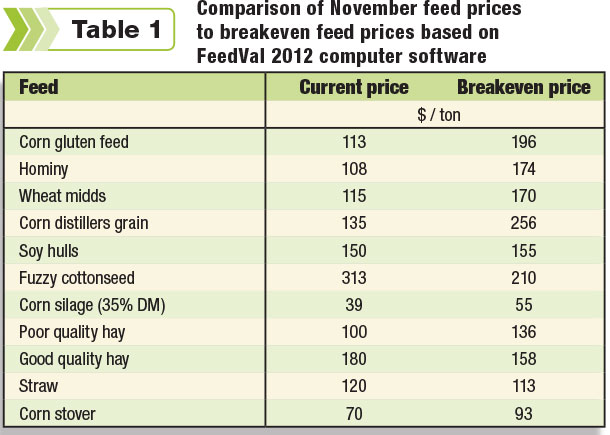As of this writing (early December 2015), milk prices in the first quarter of 2016 may be dropping as the holiday demand for butter and cheese declines. Current butter and cheese prices are higher in the U.S. compared to the world market, while U.S. milk powder prices are similar to the world market.
Feed prices are stable with corn at $3.75 to $4 per bushel, soybean meal prices may decline to less than $325 per ton with a large South American crop being harvested, high-quality alfalfa hay remains greater than $200 per ton, and fuzzy cottonseed is greater than $330 per ton as acreage was reduced by 20 percent in 2015.
Farmers enrolled in the government dairy program (Margin Protection Program) may need to have purchased protection at $7.50 or higher per hundredweight (cwt) to get a return on their investment.
Therefore, navigating the 2016 feed challenge will include close scrutiny of forage quality, assessing the role of byproduct feeds and comparing feed costs. Let’s break this down.
Monitor forage quality
Forage quality is an important measurement due to low-quality first- and second-cutting hay or haylage due to rain delays or damage and advanced maturity in many parts of the country during the last growing season. Corn silage in some areas is too dry (greater than 38 percent dry matter), which can reduce feed intake and limit silage fermentation.
Starch digestibility (seven-hour test) may be slowed, which reduces availability to rumen microbes. Starch digestibility in corn silage and high-moisture corn will increase during storage.
Dairy farmers must continue to monitor changes in neutral detergent fiber digestibility (NDFd), undigestible neutral detergent fiber (uNDF) and rumen-fermentable starch in corn silage. Summer legume or grass quality (third and fourth cutting) may be higher in quality.
In the Midwest, each point in relative forage quality (RFQ) may be valued at 1 dollar-point on a hay-equivalent basis or 90 percent dry matter. If NDFd is below 50 percent, you may need to lower the level being fed or consider replacing with a higher-quality forage or byproduct feeds.
Role of byproduct feeds
Byproduct feeds continue to be an excellent value, based on their nutrient content and evaluation in November using FeedVal2012 results available through the University of Wisconsin.
Table 1 lists byproduct feeds and forages using Midwest feed prices. Corn gluten feed, wheat midds, corn distillers grain and hominy are good buys.

Fuzzy cottonseed is not a good buy, but dairy managers need to consider its non-nutrient value in the ration (effective fiber and slow release of polyunsaturated fatty acids, which are rumen-friendly factors). If forage NDFd or uNDF values are not optimal, consider replacing 3 to 5 pounds of low-quality forage with a byproduct feed ingredient.
Substituting soybean seed for fuzzy cottonseed
Soybeans may be more economical than fuzzy cottonseed and can be raised on the dairy farm (which means less “out-of-pocket” protein purchases). Dairy cattle can be fed raw soybean at less than 3 pounds per cow per day to replace oil from fuzzy cottonseed. Grind raw soybeans to expose the raw soybean seed containing anti-protein enzymes (such as trypsin inhibitor) to microbial destruction.
Do not mix raw soybeans with urea as raw soybeans have urease, which converts the urea to ammonia and reduces intake.
Roasting or extruding soybeans destroys anti-protein factors and raises the rumen-undegraded protein (RUP) from 20 percent to more than 55 percent depending on the optimal heating process (greater than 300ºF for 30 minutes with a protein dispersion index [a test for quality heating] of 12 to 15 units).
Roasted soybean seed should be processed into quarter or eighth pieces to maintain RUP value and can be fed up to 5 pounds depending on the protein and oil needed. Extruded soybean seed should be limited to less than 3 pounds due to the oil being released from the cell, which can impact rumen health and lower milkfat test via conjugated linoleic acids.
Be sure to balance ration with soybean seed replacing fuzzy cottonseed for RUP, oil content and effective fiber. (Soybean seed has little effective fiber compared to fuzzy cottonseed.) Raw soybeans are priced at $287 per ton ($8.61 per bushel) with a breakeven price of $306 per ton. The roasted soybean seed breakeven price is $373 per ton.
Higher milkfat test
Dairy farmers reported high milkfat test in 2015 and early 2016. One reason may be lower levels of NDFd in corn silage and legume and grass forages. These lower levels of forage NDFd can lead to more cud chewing, higher rumen pH and healthy rumen conditions, which is the good news. The bad news is: It can reduce dry matter intake and lower milk production.
Dairy managers should test forages for NDFd and uNDF values and adjust rations. More good news is: Milkfat is worth $3.18 per pound, while milk protein is valued at $1.32 per pound (per November prices). The strong demand for butter and ice cream may be contributing factors.
Take-home strategies
As you consider how to feed the 2015 crops and strive to make the most of them, keep these points in mind.
- Never give up milk production. With milk prices at $16 to $18 per cwt, each additional pound of dry matter intake above maintenance may yield 2 pounds more milk.
The economics of cows consuming a balanced ration is impressive; 2 pounds of milk results in $0.32 to $0.36 more income for an investment of 1 pound of dry matter at $0.10 to $0.12.
- Monitor milkfat levels, as milkfat prices currently can increase income. But determine if this higher test is due to lower-quality forage and lower NDFd levels, which could reduce dry matter intake and profits.
- Frequently test forages to evaluate changes. Select those nutrients to test based on the forage situation on your farm (NDF, NDFd, uNDF, starch levels, rumen starch degradation, sugar, fermentation profile of volatile fatty acids or other variable nutrients that occur during forage testing).
Rebalance rations to meet nutrient requirements, including metabolizable protein, amino acids, starch, organic trace minerals, vitamins and lipid levels.
- Compare your feed costs per pound of dry matter, feed costs per cwt and feed efficiency values in your area. Illinois guidelines for 2016 are $0.10 to $0.12 per pound of dry matter, feed costs under $7.50 per cwt and feed efficiency greater than 1.5 pounds of 3.5 percent fat-corrected milk per pound of dry matter consumed. If you have groups of cows, calculate these economic benchmarks for each group.
- Other golden rules include maintaining milk quality premiums, maintaining pregnancy rates, reviewing current feed additives being used and continuing hoof trimming to avoid lame cows. PD

-
Mike Hutjens
- Professor of Animal Sciences Emeritus
- University of Illinois – Urbana






